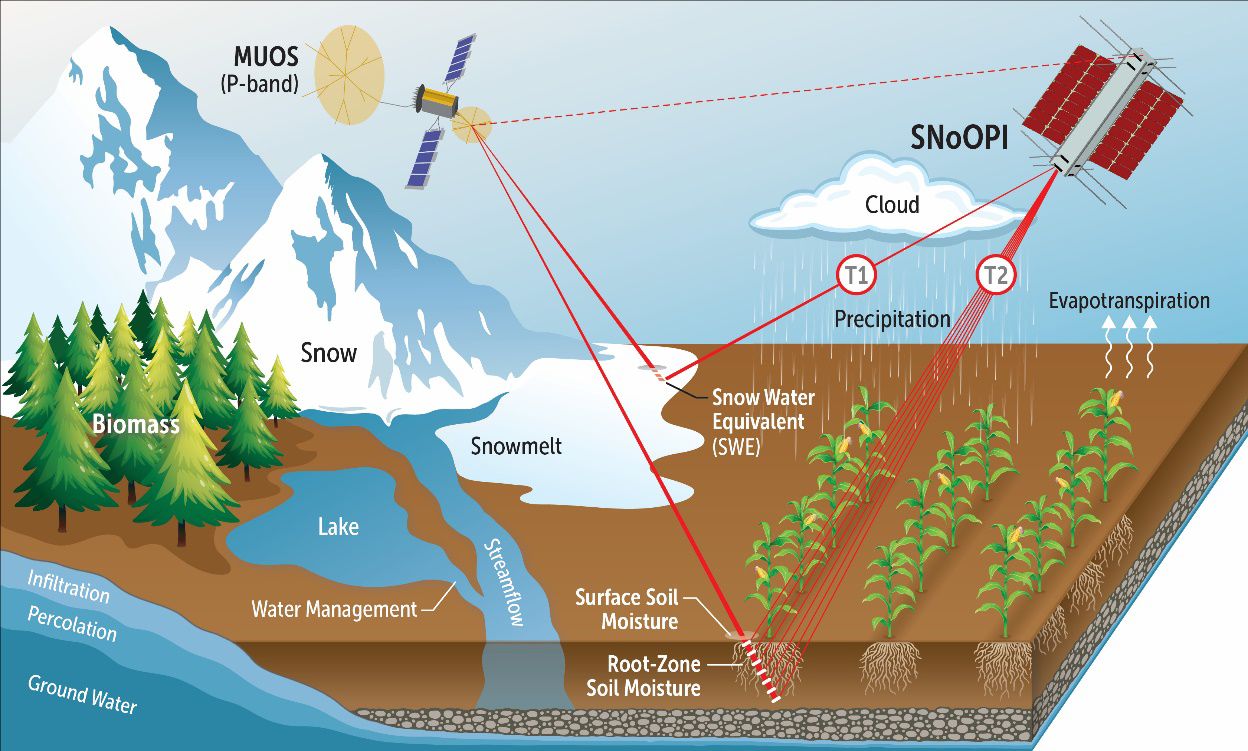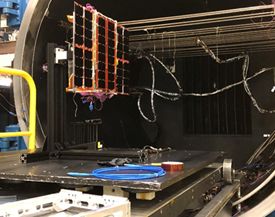
SigNals of Opportunity: P-band Investigation (SNOOPI) is a GSFC 6U CubeSat led by Principal Investigator Dr. James Garrison with Purdue University. The mission is funded by the NASA Earth Science Technology Office. It is a collaboration that includes Purdue University, Mississippi State University, NASA Goddard Space Flight Center, United States Department of Agriculture, and NASA Jet Propulsion Laboratory. SNoOPI will be the first on-orbit demonstration of P-band (240-380 MHz) signals of opportunity (SoOp). SNoOPI will demonstrate an innovative instrument that shows promise for measuring vegetative root-zone soil moisture (RZSM) and snow water equivalent (SWE) from space. Accurate measurement of RZSM, identified as a priority target variable for technology development initiatives in ESAS 2017, is of national importance and critical to food production. Microwave observations at P-band are needed to penetrate into the root zone. Snow provides freshwater during spring and summer for a large portion of the world and plays a critical role in hydrology and water management. SoOp measurements of phase-delay are proportional to SWE, whose measurement was recommended as a program element in ESAS 2017. Conventional P-band radar and radiometers are prone to RF spectrum access problems and require very large antennas to obtain sufficient signal-to-noise ratio or spatial resolution. SoOp reuses signals from existing telecommunications satellites and thus does not require a transmitter, as compared to a radar. Such signal efficiency makes SoOp very cost effective.
The objective of SNoOPI is in-space validation of the P-band SoOp technique and a prototype instrument. This is a necessary risk reduction step on the path to a science mission and will verify important assumptions about reflected signal coherence, robustness to the RFI environment, and our ability to capture and process the transmitted signal in space. The baseline mission design is driven by this objective, which will be met through demonstrating measurement of the complex reflection coefficient over various land surface conditions and showing that statistics of the reflection coefficient magnitude and phase retrieval meet the working requirements for a future RZSM and SWE mission.
SNoOPI's instrument consists of three subsystems: 1) The low noise front end (LNFE), developed from the SoOp-AD (IIP-13) airborne demonstration instrument and redesigned for a CubeSat form factor under GSFC internal funding; 2) the digital back end (DBE), a modification of the Cion instrument flying on CICERO that capitalizes on the extensive heritage of the Blackjack and TriG GPS receivers; and 3) an array of COTS antennas. LNFE has a patent-pending architecture that uses an internal calibration network based upon our experience with the Aquarius and SMAP missions. It also is capable of antenna swapping to suppress the effects of antenna phase and gain imbalances. RF circuits are shielded from out of band signals and spacecraft-generated electromagnetic interference (EMI). DBE employs a combination of off-the-shelf hardware with a custom-designed RF/CLK/Host board and will be modified to accommodate the rad-tolerant Space Micro CubeSat Space Processor (CSP) to make the instrument suitable for a future NASA Class D mission. Additionally, four P-band down-converters and a high-performance sampling clock are used to acquire data in two polarizations from the two antennas (zenith and nadir).


The GSFC-provided spacecraft bus is comprised of several COTS components from vendors such as Hyperion (star tracker and GPS receiver), Sensonor (IMU), GOMSpace (fine sun sensor and magnetometer), CubeSpace (reaction wheel), Ibeos (EPS and batteries), Blue Canyon Technologies (solar arrays), and Vulcan Wireless (radio and antenna). The flight computer was developed by GSFC along with the necessary interface boards. The instrument and spacecraft bus were integrated and tested at GSFC.
SNOOPI launched to the International Space Station on March 21, 2024 and deployed on April 18, 2024. The team had challenges working through spacecraft commissioning. A number of the attitude control system sensors were not functioning nominally. The team was able to achieve stability in a sun point configuration, take data from the instrument, and make progress towards achieving the necessary three axis control to conduct the science operations. The mission experienced a power system anomaly and eventually lost two reaction wheels. The team recently lost contact with the spacecraft and is working to regain it.


